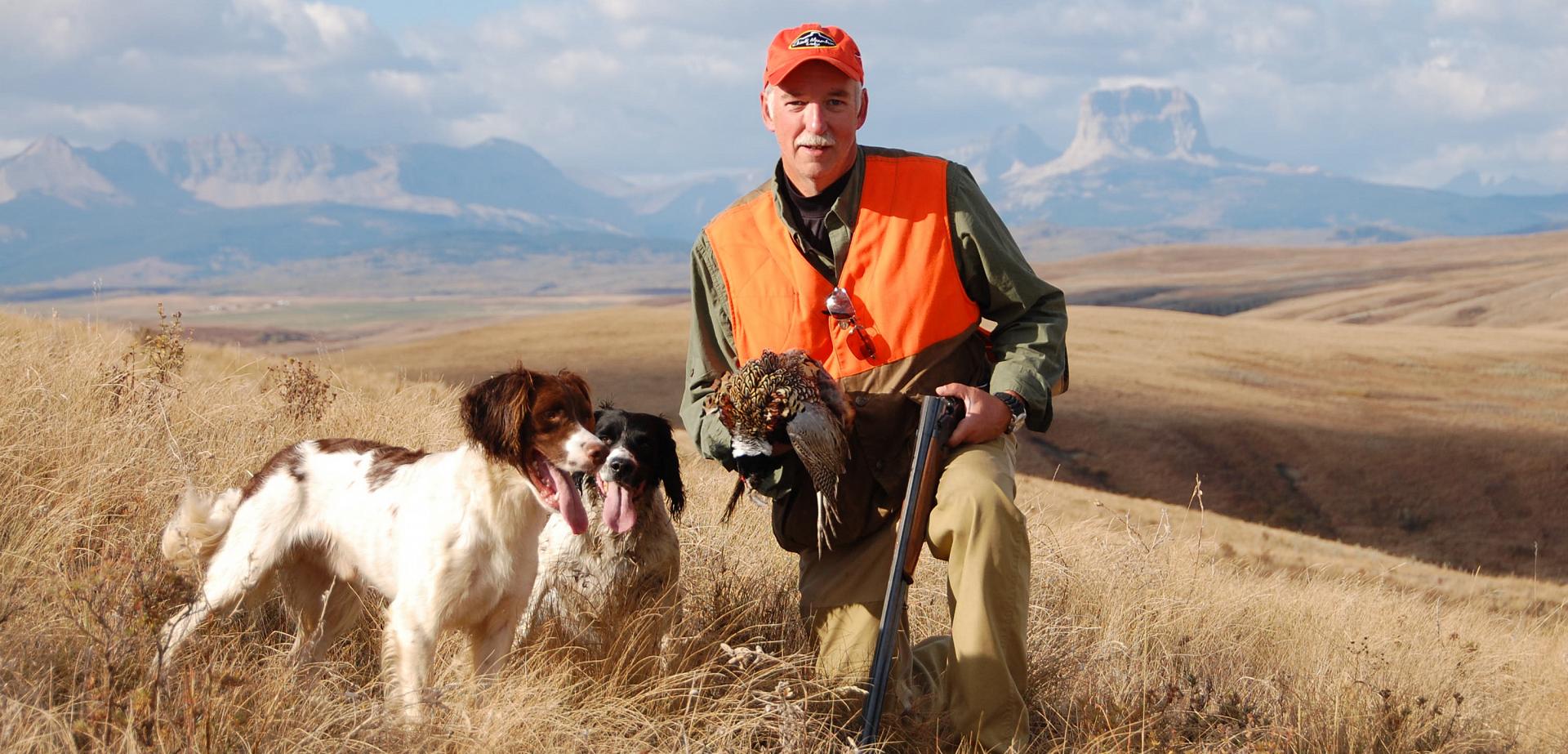Rooster reckoning
Underrating the plentiful ringneck can make you a pheasant fool
Advertisement
No game bird elicits as much divisiveness among hunters as does the ring-necked pheasant. To some, it’s an unwanted immigrant unworthy of attention, while others consider it the most challenging and desirable of all our upland game birds. In fact, it seems that for every criticism of pheasants, there’s contradictory praise—when one hunter considers him a gaudy clown, there’s another who sees him as resplendent in his coat of many colours. Think of him as fat, slow to rise and an easy target? Another hunter will tell you that getting a rooster to flush is a challenge unto itself, and that once airborne with a tailwind, there’s no upland bird that flies faster.
Then there are those who believe that because pheasants are an introduced bird, they don’t even belong on our landscapes. Given that we’ve had sustainable wild pheasant populations in Canada for more than 100 years, however, I find it difficult to not think of them as one of our own (see “The ringneck’s arrival” below). You can choose to take umbrage at the notion of pheasants as a worthy game bird, but I’ve yet to meet a hunter who’s turned down an invitation to hunt them.
Advertisement
I first hunted ringnecks in the early 1980s around Brooks, Alberta, which is regarded as the pheasant capital of Canada. Birds were plentiful, thanks to an abundance of suitable habitat, a series of mild winters and springs, and a wild population supplemented by an active release program. I quickly came to appreciate pheasant hunting, choosing to focus not on what they weren’t, but rather on what they are—smart, tough survivors that can outwit the most experienced dogs, leave top wingshots shaking their heads and, for those hunters who are successful, an exquisite dining experience.
Pheasant hunting success doesn’t come easily. These are wily, resilient birds, able to survive numbing winters and stifling droughts, and cope with predators ranging from hawks to coyotes. And they’ll most certainly outwit you if you don’t hunt them with smarts and determination.
The habitat
Advertisement
Quality habitat is necessary to sustain abundant wild pheasant populations, but on a yearly basis, pheasants live or die with the weather. Populations can decline rapidly during extremely harsh winters, and annual productivity will suffer when the spring is unusually cold and wet. Fortunately, ringnecks have an amazing ability to rebound quickly when conditions are favourable.
Pheasants require three primary habitat attributes, and hunters need to keep these in mind. First, they need a reliable food source, typically cereal grains or corn. Second, they require grasslands for nesting and loafing. And finally, they need protective cover from weather and predators—fencerows, shelterbelts, ditch banks, marsh edges, brushy coulees and shrub land all offer this security.
Early in the hunting season, pheasants will be dispersed wherever their habitat needs are met. After the harvest, they become more concentrated, moving into the best remaining cover. They’ll most often feed from early to mid-morning, then look for a sunny resting spot protected from the wind, usually along ditch banks and hill bottoms or on warm, south-facing slopes.
Hunting tactics
Pheasants are the only upland bird that require you to formulate and execute a game plan if you’re going to be successful. They’re wary by nature, and mature birds quickly learn to associate the sound of vehicles and people with danger. That means silence is golden when approaching suspected holding cover.
Since roosters almost always prefer to run rather than fly, you should evaluate the available cover and devise a strategy to capitalize on this tendency. The objective is to have birds flush within gun range, which is often easier said than done.
Release hunts
While hunting wild roosters is acknowledged as a challenging and exciting day afield, chasing released birds should not be dismissed as pedestrian. Pen-reared ringnecks quickly learn the score and are soon nearly as untamed as their wild brethren.
I was recently at a large ranch where 200 roosters were released one evening. Five of us hunted the birds over the next day and a half—we found about half of them and bagged just 55, testament to the bird’s ability to rapidly go wild. These were strong-flying birds, and we were all left embarrassed more than once by missed shots. It was definitely not fish-in-a-barrel hunting.
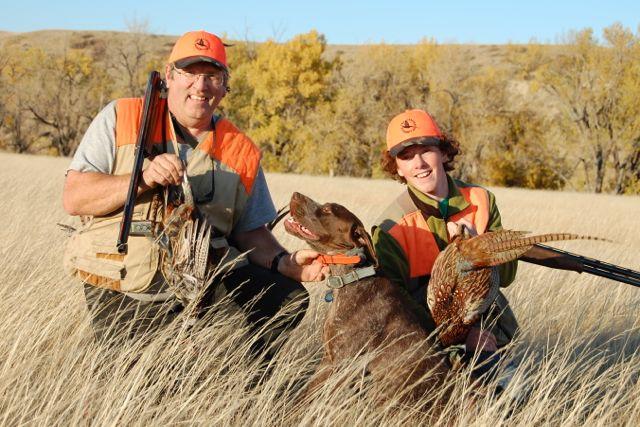
Release hunts are ideal for beginners.
Released bird hunts offer several advantages over hunting wild roosters. For starters, you’re not bound by seasons or bag limits, and you’re all but guaranteed to flush at least a few birds, as they’ll generally hold a little tighter than wild pheasants. That makes these hunts ideal for beginners. It’s hard not to enjoy these noisy, colourful birds that have few peers as table fare. And when pheasants have been raised under the proper conditions, they’ll run, flush and fly just like wild roosters, making them a near-equal challenge.
Group hunts
Classic open-country pheasant hunts are often enjoyed by groups of four to eight hunters, with or without dogs. These hunts are best conducted by using a combination of pushers and blockers. The latter should quietly position themselves at natural choke points or at the ends of likely holding cover. Once the blockers are in place, the pushers start moving toward them, usually into the wind to provide optimal scenting conditions for the dogs.
The pushers should walk slowly in a zigzag pattern (above), stopping regularly, as roosters have the nerves of gunfighters and will sit tight, hoping you’ll walk on past. Periodic stopping can unnerve them and they’ll typically respond by flushing. Don’t worry if you’re on the flank during the push—you’ll get your share of shooting when birds trying to escape out the sides hit the end of the cover and flush.
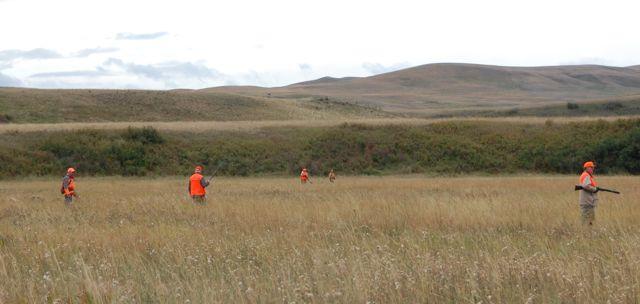
Flushes can come quickly during group hunts, making it important to wear blaze orange.
Roosters will often move right to the end of any available cover, where they’ll gather and sit tight, so be sure to push right to the end. The shooting can be fast and furious when several roosters erupt together, so it’s important for both the pushers and blockers to wear hunter-safety orange and to allow the birds to get well up in the air before shooting.
Hunts with dogs
Whether they’re heading afield alone or with a partner, most pheasant hunters hunt over a dog. It’s a less frantic approach than joining a large group, and it’s well suited to hunters of all ages and experience levels. The key to success here is to be patient with the dog.
At best, pheasants don’t consistently sit tight for points, which makes for a lot of false points or flushing dogs excitedly outpacing gunners. When there’s only one or two gunners working large expanses of cover, roosters tend to double back, so you have to trust your dog and give him his nose. Otherwise, trying to outguess your dog is generally a recipe for disappointment. That said, cagey roosters can make even an experienced dog look like a piker when it comes to the art of escape.
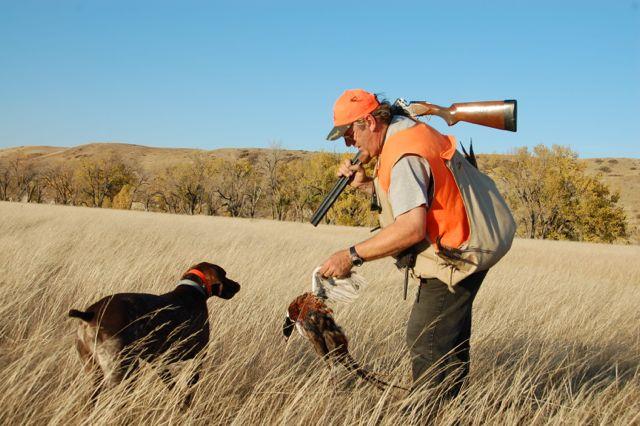
When hunting pheasants over a dog, the key to success is patience.
When there are no blockers, it’s important to stay close to your dog. Once a rooster starts to run, it will generally keep going until it runs out of cover or gets flushed by your dog. If your dog does point and hold a rooster, keep in mind that ringnecks are not like other upland birds in that it’s not unusual for them to flush in a different direction from which they’re pointed. Generally, they’ll flush upwind, but as often as not, they’ll turn downwind—straight back in the direction from where you approached them.
If you do flush a bird and miss the shot, watch where it resettles. Unlike Hungarian partridge or sharp-tailed grouse, pheasants tend not to land in the first cover they reach. Wherever a rooster settles, don’t abandon the cover you’re hunting to go after it, as he’ll invariably run immediately upon landing. It’s tougher to flush a mature pheasant twice than any other game bird; identifying where he lands after a flush gives you a starting point for a search, but little more.
Hunts without dogs
Pursuing pheasants without a dog definitely ups the ante, but it doesn’t have to be a loser’s bet. Be smart about where you hunt, opting for fringe habitat and other less-pressured cover that you can cover thoroughly. Ditch banks are productive and easily hunted solo or in pairs, as are brushy draws and coulees, fencerows and shelterbelts. Some hunters prefer to split up and work towards each other in these areas, acting as both pushers and blockers for one another. Roosters will often see or hear one hunter, then stop running and hold until they’re flushed.
When you’re solo, the challenge of hunting pheasants running in linear cover can be overcome by simulating a blocker. To do this, many hunters park their vehicle at one end of the cover, then walk to the other end and hunt back toward it. Some even leave their vehicle’s sound system on, believing the music will scare birds into holding tighter.
Whether you’re alone or with a buddy, hunt quietly and stealthily. Surprised roosters will flush, while suspicious ones will run. The denser the habitat, the tighter the roosters will hold. So, in the thick stuff, a stop-and-go approach pays dividends.
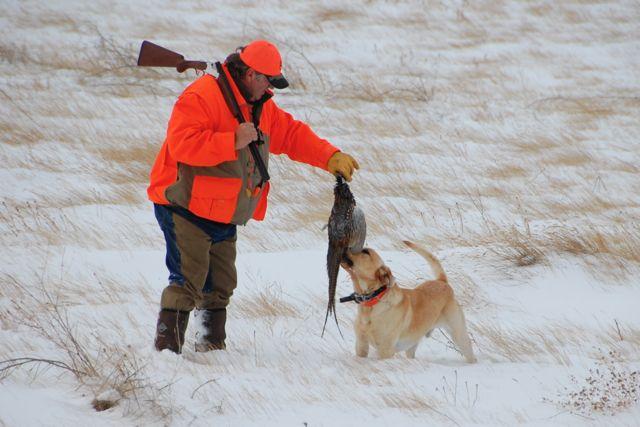
Release hunts make for great winter wingshooting.
Guns and loads
Ringnecks have a reputation for being tough to bring down, leading many hunters to believe a 12-gauge is the best option. While it’s hard to argue with the 12 as effective for any wingshooting, I prefer a 20-gauge for pheasants. You can put a lot of kilometres on your boots during a pheasant hunt, so I appreciate the lighter weight of a 20. Even when I’m tired near day’s end, a 20 still comes up quickly and swings easily, translating into more downed birds.
While some pheasant hunters prefer loads of #4 or #5 shot, I believe that #6 shot is the most effective, no matter what gauge I’m shooting. A 20-gauge, one-ounce load of #6 is more than adequate for any rooster at all practical ranges.
Part of the reason some hunters think they need extra firepower lies in the physical appearance and large size of a rooster. The tail of a mature pheasant can account for half its body length, for example, leading many hunters to shoot behind them. I’ve learned to focus specifically on the distinctive white ring on the rooster’s neck. If you consider that ring your target and get out in front of it with your swing, you’ll find that your shooting percentages will rise dramatically.
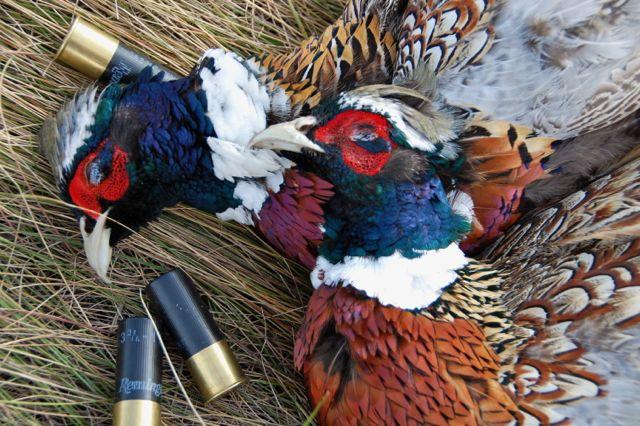
A 20-gauge, one-ounce load of #6 shot gets the job done.
Roosters are slow, bold and noisy on the flush, almost challenging you to take what appears to be an easy shot. It’s amazing, however, how many roosters simply don’t have the good sense to fall if you hit the switch too quickly. Don’t let yourself be rushed—take the time available to properly mount and swing your shotgun. Most often, ringnecks rise almost straight up before levelling out and beginning a gradual sailing descent. It’s easy to shoot over them, so be sure to hold below the bird as you swing.
It’s not unusual for cocks to flush well out of range, whether they’re being pushed by dogs or they simply ran out of cover while escaping on foot. Often, they’ll turn and fly directly back toward you. If that happens, shoot while they’re still well out, giving yourself time for two shots. Hunters often let them get too close before shooting, but by then the birds have picked up speed and are difficult to hit. Plus, you don’t want to turn and shoot behind them if you miss on your first shot.
If roosters are merely winged, they’ll invariably start running once they hit the ground. These birds can be extremely difficult to find and retrieve, so it’s always a good idea to take a second shot to anchor them in place. Otherwise, you stand to be counted as yet another hunter to be outwitted by the crafty ringneck.
The ringneck’s arrival
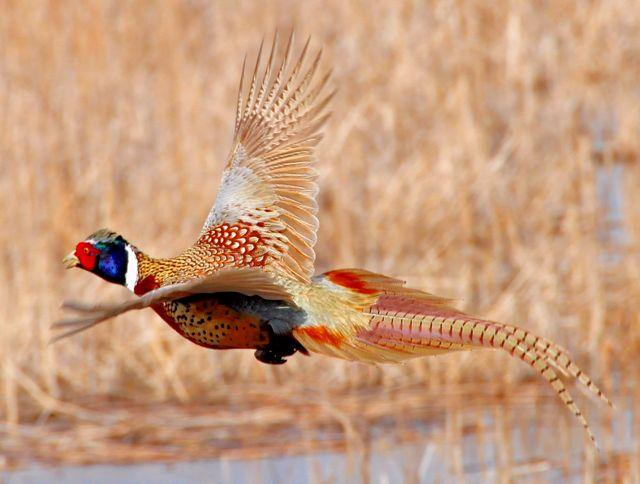
While ring-necked pheasants are native to Asia, they’ve been introduced in many countries around the world. The first releases in North America date back to the early 1700s, but the first truly successful introduction is generally recognized as having occurred in Oregon in 1881. Just 11 years after that introduction, Oregon’s first hunting season saw a harvest of 50,000 birds. Here in Canada, the first pheasant introduction took place just south of Calgary in 1908. Today, you can hunt ringnecks in the wild or on preserves in every province except Newfoundland and Labrador.

